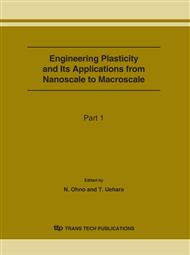p.477
p.483
p.489
p.495
p.501
p.507
p.513
p.519
p.525
Increase of Stress Intensity near Free-Edge of Elastic-Creeping Bi-Material Interface under a Sustained Load
Abstract:
The transition from SSC to LSC ahead of a crack tip (notch root) or an ordinary interface edge (bad pair) causes stress relaxation and the decrease of stress intensity in general. However, the good pair bi-material and the bad pair bi-material with weak elastic stress singularity in this study show the inverse phenomenon under the transition. The results indicate that the stress near the interface edges of both cases, which have no or low stress singularity at the loading instant, increases and brings about the stress concentration during the transition. In addition, the creep strain distribution in the early stage is different from that occurred in the transition of an ordinary interface edge (bad pair) or a crack tip (notch root).
Info:
Periodical:
Pages:
501-506
Citation:
Online since:
June 2007
Price:
Сopyright:
© 2007 Trans Tech Publications Ltd. All Rights Reserved
Share:
Citation:


